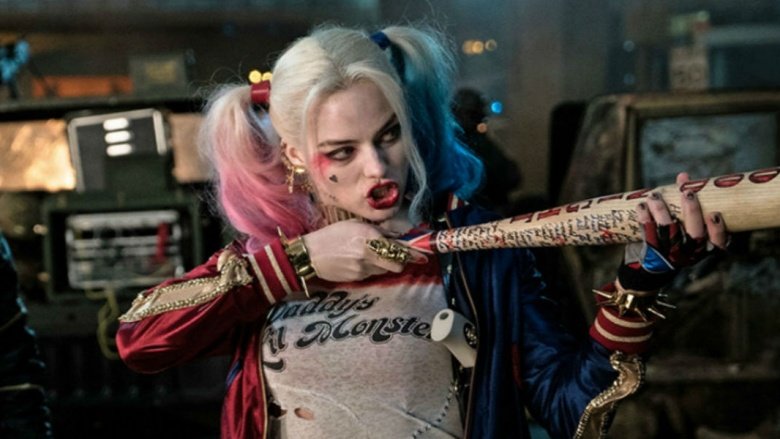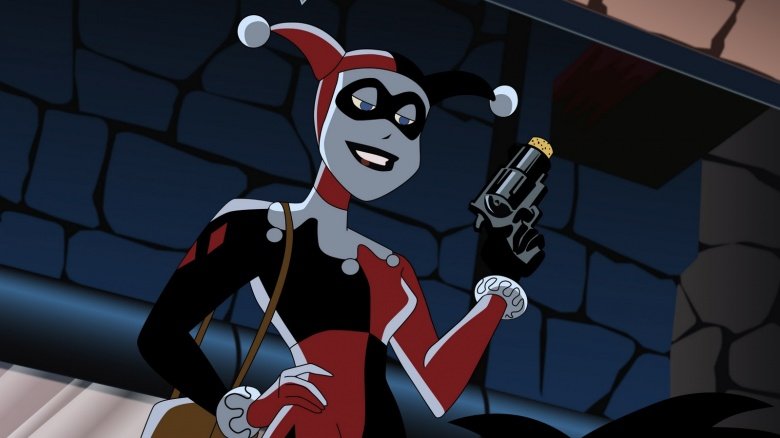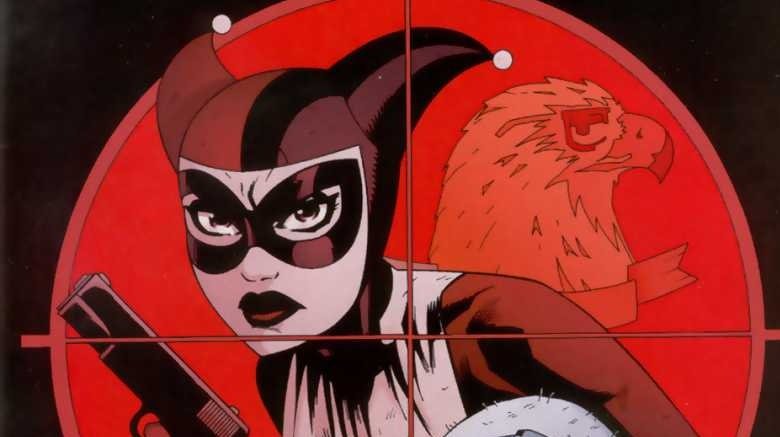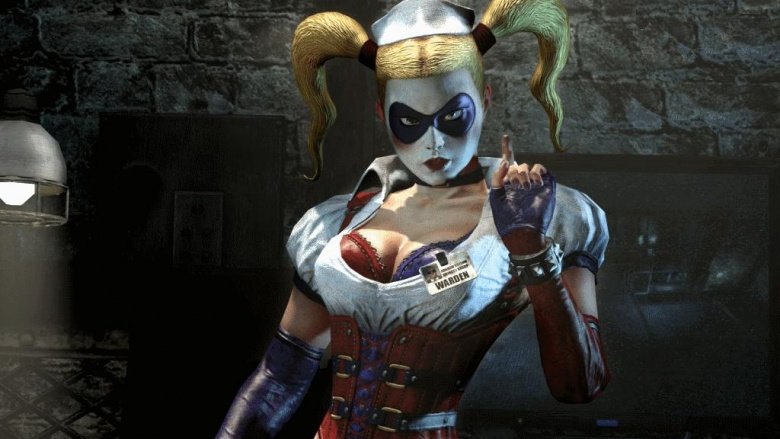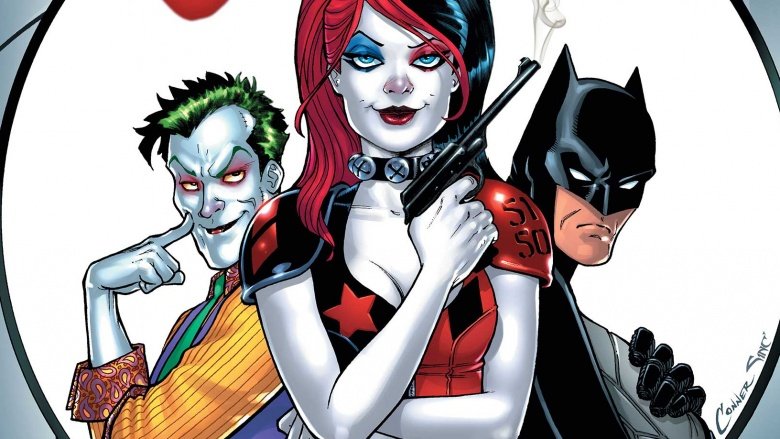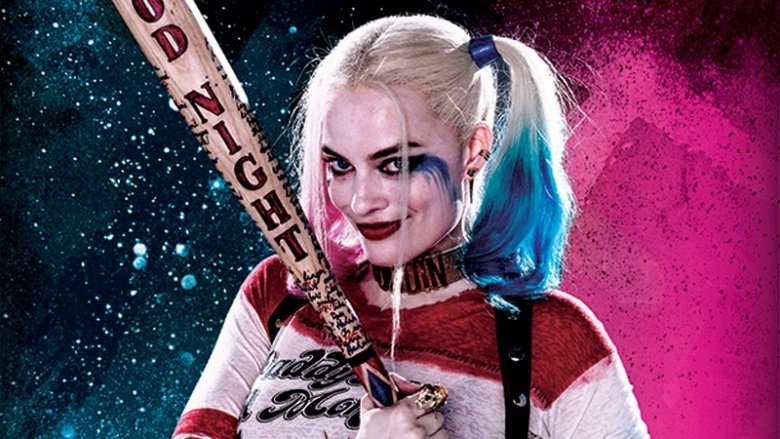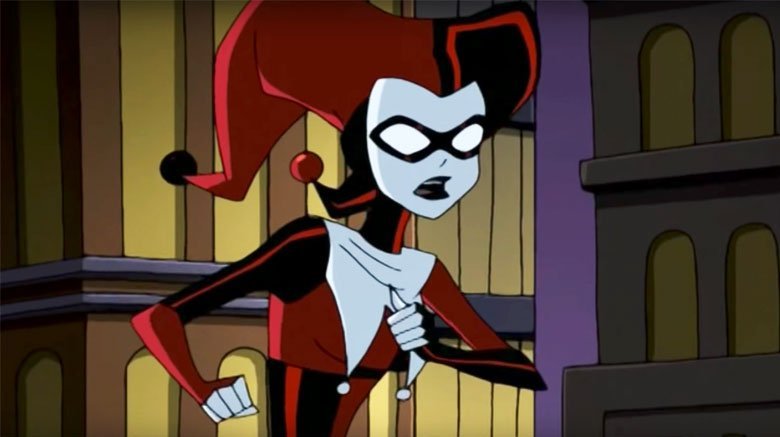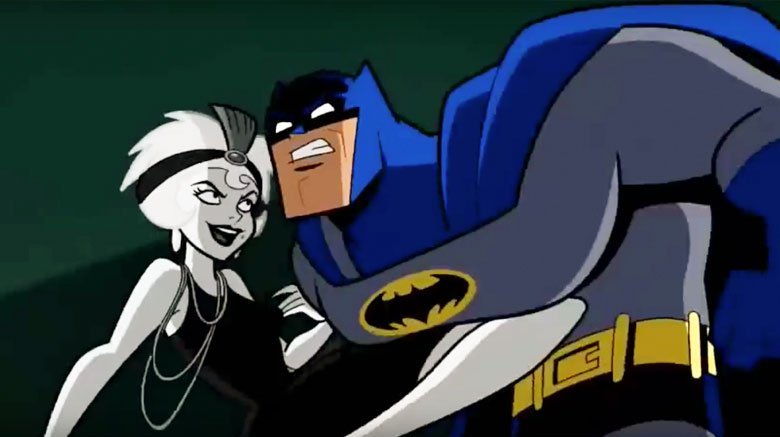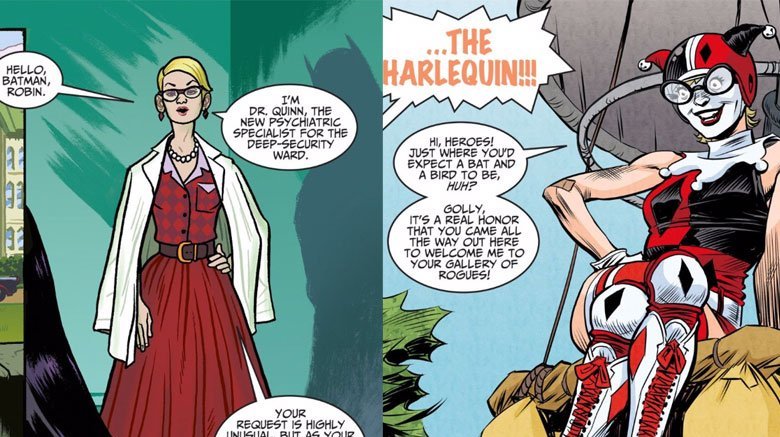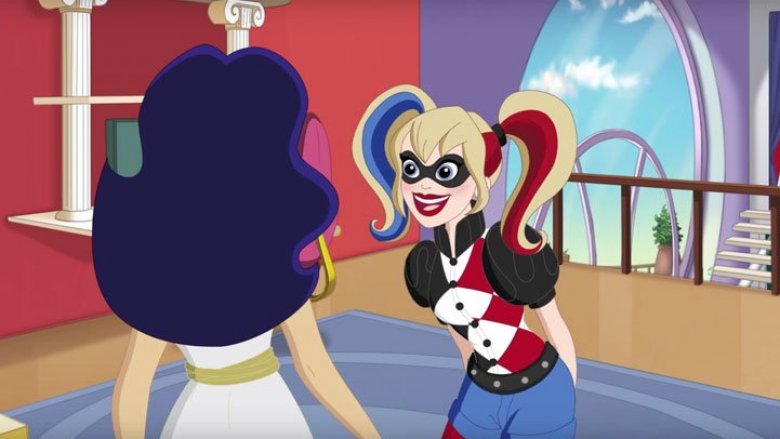How Harley Quinn Should Really Look
Harley Quinn might still be a relative newcomer to the DC Comics scene, but she's already gone through some significant style and personality shifts in the years since her debut. What moviegoers got to see of the character with Margot Robbie's portrayal in Suicide Squad was just a sliver of her story. Here's a run-down of the most significant moments in Harley's evolution.
Batman: The Animated Series
Harley Quinn made her world debut as the Joker's cork gun-toting, right-hand gal in Batman: The Animated Series in 1992. The character was inspired by a scene from Days of Our Lives, featuring actress Arleen Sorkin rolling around in wild harlequin gear and makeup. Producer Paul Dini was old college pals with the actress, so when he saw the taped bit, he told Vulture, "I thought, 'maybe there should be a girl there... Should the girl be like a tough street thug? Or a hench-person or something?' And then suddenly the idea of something funny struck me." He recruited Sorkin herself to do the character's vocals, including her first utterance, "It is to laugh, huh, Mistah J?" which set the tone for the wild fun to come with Harley.
The show was also first to explore her history as Dr. Harleen Quinzel, the Joker's psychiatrist at Arkham Asylum. After a few therapy sessions, she fell in love with and freed the maniacal madman, adopting her own nefarious clown identity by his side. She'd also forge a friendship with fellow female baddie, Poison Ivy, along the way. Her checkered red and black leotard and headdress ensemble paralleled her image in the series as a real card who didn't need sex appeal to rule a room. Click here to see the full artwork for the image featured above.
Harley's early comic book appearances
After instant fanfare arose with her cartoon run, Harley made her comics debut in Batman Adventures #12, which is when the character's look started to get a few key upgrades. The first few differences were subtle, including the addition of colorful poms to the tips of her hat and a little more décolletage on display. Soon after, though, as the details of her fateful seduction by her puddin' the Joker became a focal point of her character (particularly in the award-winning one-shot comic book written by Dini in 1994, The Batman Adventures: Mad Love), she started to show a little more shape and a lot more sass.
In December 2000, her standalone Harley Quinn comic series launched, and through its 38 issues, eventually broke her of her romantic entanglements with the Joker (in pursuit of a relationship with Poison Ivy). The new series gave her a less cartoonish appearance with more defined bodice and facial features, but it still mostly kept her costume the same for its four-year monthly run.
Batman: Arkham Asylum
Harley's sex appeal began to really shine through when she appeared in the hit 2009 video game Batman: Arkham Asylum. In fact, she was practically unrecognizable in her racy ensembles. Her backstory was still much the same as the character fans had grown to know and love for so many years, sure, but her look was sharply different—she wore blonde pigtails, a bodice-baring corset fit with a miniskirt and thigh-high boots, and she was decidedly not as light-hearted as she'd once been. Dini, who'd created the character in the first place and wrote the game, defended the controversial changes, saying, "I wanted to make it clear that Harley Quinn was out of her mind."
This new Quinn would also appear in the video game's sequels, Arkham City, Arkham Origins, and Arkham Knight, each of which tinkered with her threads just a little. In City, she regained her red and black suit coloring, but it was a total dominatrix look and they even added some color-dipped tips to her tied-back blonde tresses.
The New 52
When DC Comics rebooted Suicide Squad as part of its The New 52 series, things really started to change. Harley got a major style overhaul, introducing her red and blue pigtails, hot pants, and high heels in the new series. In Suicide Squad #7, released in May 2012, the series also revamped her origin story a bit to include the chemical skin alterations later seen in the cinematic version. The next year, the reboot of her standalone series Harley Quinn dropped and ushered in the era of her blue and pink eyeshadow styling. Also, although the colors of her costume and hair harkened back to her signature red-and-black, her midriff, legs, and more were still on full display.
Suicide Squad
David Ayer's Suicide Squad followed suit in featuring Harley Quinn's allure onscreen. It wasn't the first live-action iteration of the character (she also appeared in the WB's short-lived television series Birds of Prey, portrayed by Mia Sara, with a decidedly more wholesome image), but it was her first appearance on the big screen.
In the flick, Robbie's version of Harley also sported pigtails partially dyed blue and pink, tiny shorts, a tattered t-shirt, red varsity jacket, a ton of tattoos, and boots. While the get-up paid homage to the aesthetic of some of the past versions of the character, particularly The New 52 and the Arkham video game series, the look also arrived as its own new spin on the character. Bruce Timm, who helped originate Harley in the original series, said that this new HQ was "interesting" and that he "thought she looked really cool." Dini, meanwhile, thought the Daddy's Monster approach the filmmakers took to the character was a good way to make it work. "I know it's jarring to a lot of the people who love the classic Bruce Timm suit," he said. "I love it myself. But in that world, I just don't see it happening. It's a rougher, more street look. I think it works fine."
The changes have since been incorporated into comics canon for Harley Quinn as part of the DC Rebirth initiative, launched in the summer of 2016. In this new gen of Harley Quinn, she's got the screen version's hairstyle, makeup, and a much more urbanized garment game.
The Batman
Considering how her initial appearances on BTAS had made her an instant fan favorite, and how her foray into the world of comics saw her cast as a headliner from the very beginning, it's no surprise that Harley Quinn would make an appearance in the next animated version of Batman, too. The only thing that is a little shocking is that they actually held off on introducing her until The Batman was well into its fourth season.
This time around, Harley's origin was a little different. Rather than being the Joker's therapist at Arkham Asylum, writer Paul Dini reintroduced her in 2007 as a daytime talk show host in the vein of Dr. Phil. Just, you know, slightly more supervillainous. When her show is cancelled after an ill-fated on-air ambush of Bruce Wayne, she ends up joining up with the Joker, and the rest is criminal history.
Visually, the costume on The Batman is pretty similar to her original Bruce Timm design, just translated into the more exaggerated Jeff Matsuda style that made The Batman so distinct from its predecessor. It's got the same color-blocked style and floppy collar of the original suit, with the black swapped out for a deep red, and a slightly more voluminous hat. The other major difference? Harley's traditional domino mask. The original BTAS model sheets had allowed Harley's mask to emphasize her expressions, and her big, visible eyes were a nice visual cue that she was a sympathetic character. The Batman's Harley, on the other hand, had a mask with blank white eyes not unlike Batman himself, underlining the fact that she was a little less lovestruck than her previous incarnation.
Batman: The Brave and the Bold
Like she had with The Batman, Harley would eventually make her way onto Batman: The Brave and the Bold, and once again, she was a later addition to the cast, making an appearance in the show's 45th episode, "Emperor Joker." That's about where the similarities end, though.
Rather than adapting her familiar red-and-black design for the BATB style, this Harley takes her visual inspiration from a monochromatic 1920s flapper. It's a great look, but it seems like a pretty weird choice until you realize that it's all building to a gag where the Joker—possessed with the reality-altering power of the fifth-dimensional Bat-Mite—steals her voice and causes her to communicate with silent movie-style dialogue cards.
With this episode marking her only appearance in the series, black-and-white Harley is an often overlooked piece of the character's sartorial history, and marks the occasion that saw her going the furthest from her original look. If you're a Harley Quinn costume purist, however, don't worry too much. They threw something in for you, too. Harley might not wear her classic costume on Brave and the Bold herself, but—weirdly enough—Bat-Mite does.
Batman '66
One of the truly great things about the Batman '66 comic series was that it allowed the creators to reimagine modern characters who never had the chance to make an appearance opposite Adam West in the style of the classic TV show. Poison Ivy, for instance, was reintroduced as a deadly southern belle, Killer Croc was cursed into his reptilian form by ancient Egyptian sorcery while working as a henchman for King Tut, and Bane stepped into the spotlight as a Mexican luchador committing crimes from the confines of a wrestling ring. Early on in the series, though, Jeff Parker and Joe Quinones introduced the Arkham Institute's newest psychiatrist: Dr. Holly Quinn.
With horn-rimmed glasses and a black-and-red diamond patterned blouse, Holly had plenty of visual cues for where her character would eventually wind up. The thing is, she was actually built into the story as a bit of a slow burn. She's introduced in Chapter 7, and doesn't end up becoming the Harlequin until Chapter 62. When she does, she comes complete with a roller-derby style outfit that serves as a pretty solid combination of her original Animated Series design and the "New 52" costume that she was wearing in the main continuity of the time.
Whether or not the '66 version stands up against all of Harley's other costumes is certainly up for debate, but there's one thing we all have to agree on: "Holly Quinn" is a way better name to start out with than "Harleen Quinzel."
DC Super Hero Girls
While most of Harley's costumes tended to get skimpier and skimpier as time went on, there's one notable exception: the DC Super Hero Girls toy line. Considering that it's directed at little kids about young heroines attending a superhero high school, one assumes that a bondage collar and a "Daddy's Li'l Monster" t-shirt would've come off as slightly inappropriate.
As a result, the Harley of Super Hero Girls is more into playing good-natured pranks and making YouTube videos about them than, you know, being an accessory to multiple murders, and has an outfit that blends bits and pieces of her previous costumes into a casual, but surprisingly preppy ensemble. She's got the black-and-red diamonds that have been there since the beginning and the expressive domino mask of The Animated Series, with the two-tone dyed pigtails of the Arkham games and Suicide Squad movie, matched up with a heaping helping of Degrassi thrown in for good measure.
